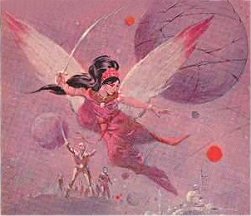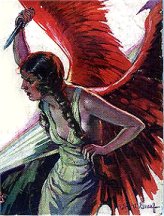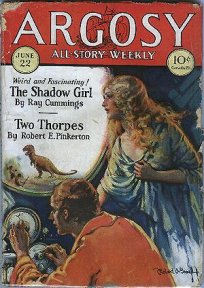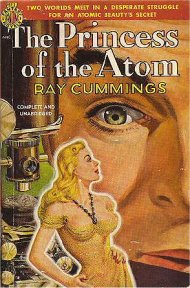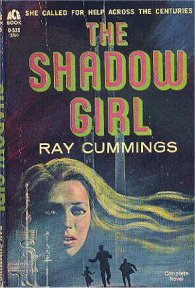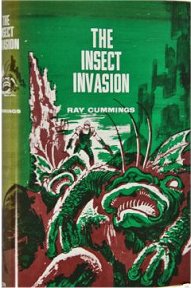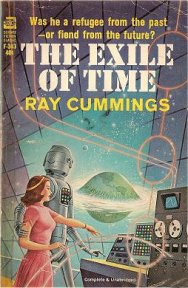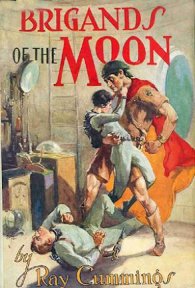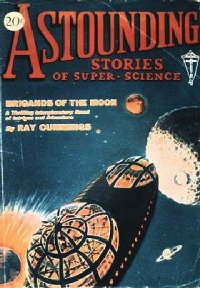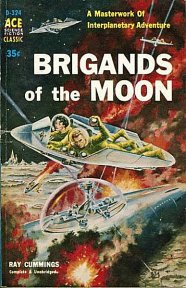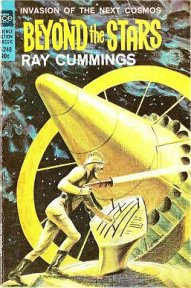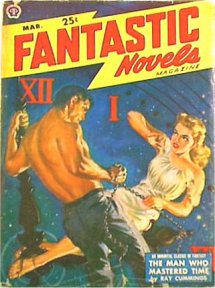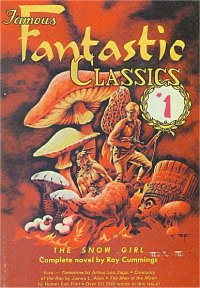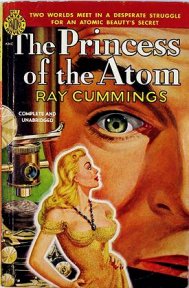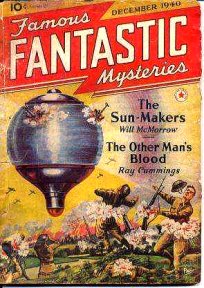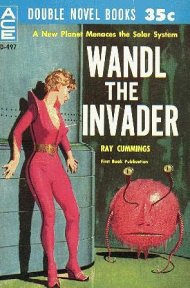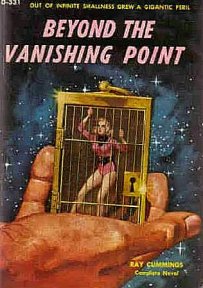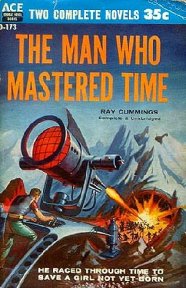.
Blame Lin Carter for this one. Here's the story, I got
interested in the Callisto series, because of an essay written by Carter
where he basically admitted that he was ripping off, or paying hommage
to Barsoom. He made no bones about it. Basically, he wanted
to do a Burroughsian interplanetary adventure, and he copied Barsoom closely.
Of course, Carter didn't want to use Mars for his "Barsoom" style adventure.
Obviously, it was already taken. Michael Moorcock and Leigh
Bracket got around that by catapulting their character far into the past,
so that was out. Venus and the Moon were out because
Burroughs and Kline had already covered those grounds.
So that left the other worlds, Mercury and the giant satellites of Jupiter
and Saturn beyond the asteroids. The only trouble was that
Manly Wade Wellman had already written Sojar of Titan back in 1941,
during the pulp age. Meanwhile, Mike Resnick, a contemporary
of Carter and a Burroughs fan himself had turned out two novels about a
Jovian Satellite... Goddess of Ganymede and Pursuit on
Ganymede in 1968. So that was out. And finally, Carter
recalled that Mercury had been used by Ray Cummings for some distinctly
Burroughsian adventures in Tama of the Light Country and Tama
Princess of Mercury. So that was out. In the
end, he decided to settle on Callisto.
But that kind of got me interested in some of these other pseudo-Burroughsian
tales. Who knows, someday I may dig up Sojar of Titan,
or the two Ganymede novels and write about them. But in the meantime,
I wound up doing a bit of research on Ray Cummings and Tama.
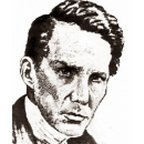 Ray (Raymond King)
Cummings (1887-1957) was one of the early pioneering pulp science fiction
writers. Cummings' big claim to fame was that he was the only science fiction
writer who had ever worked directly for Tom Edison as his assistant.
Ray (Raymond King)
Cummings (1887-1957) was one of the early pioneering pulp science fiction
writers. Cummings' big claim to fame was that he was the only science fiction
writer who had ever worked directly for Tom Edison as his assistant.
That was heavy mojo, Thomas Edison, inventor of the light bulb, the
phonograph, the motion picture and about a jillion other things, founder
of the electrical company that bears his name, was one of those strange
polymaths that the age seemed to produce. A kind of renaissance
man of invention and technology. He wasn't alone. He shared
his age with guys like Nikola Tesla, Alexander Graham Bell and even Henry
Ford, the Wright Brothers, and Charles Lindbergh, experimenters and tinkerers
who shaped much of the world we know today and who became legendary figures.
Nowadays it's all corporate. Quick, can you name the guy who invented
the VCR? How about the cell phone? There is no modern
equivalent. It would be as if Bill Gates or Steve Jobs, in
addition to coming up with Microsoft and Apple Computers, also invented
VCRs, Camcorders, giant foam styrofoam hands for football games, and were
space shuttle pilots in their spare time.
Arguably, there was a fair bit of inflation in their legends, Edison,
for instance, had an entire staff of inventors working for him. Ford
and Lindbergh just verged on being Nazi cranks. The question
of who really were the original creators of such things as telephones,
motion picture projectors and light bulbs is disputed. But
during their heyday, and well into the late 20th century when everything
got corporate, Edison was a near mythical figure. Indeed, he
was almost a character of fiction - magazines published the adventures
of young Tom Edison, Tom Swift was a rip off of that. And when reading
audiences were shocked by Wells' War of the Worlds, well, lesser
fiction writers were quick to set things right with adventures where Tom
Edison and Nikola Tesla gave the Martians what for.
So for Cummings to be able to associate his name with the fabled Edison,
that was heavy mojo. Sadly, as is so often the case, there's less
there than meets the eye. Cummings in his five years as an
assistant seems to have been mostly a clerk, not a junior inventor, his
job seemed to be mostly labeling and cataloguing early phonograph records.
His signature can be found on many historical phonograph dicks.
Apart from the Cummings life featured the usual, sometimes hardscrabble,
wanderings of many who would become writers. He attended Princeton
for a few months, lived in Puerto Rico where his family exported oranges,
and later went to Wyoming where his father searched for oil, held various
jobs before making it as a writer.
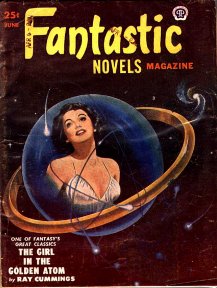
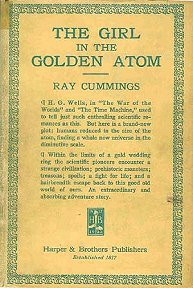
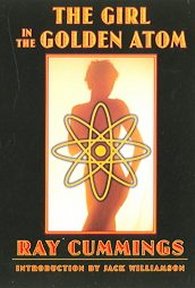
In 1919, he broke through as a writer with The Girl in the Golden Atom
and never looked back. Through the course of his pulp career, he
published more than 1000 stories, mostly in genres other than science fiction
and fantasy. Of his SF work, it's estimated that he had roughly
150 stories, of which 21 were novel length. His high water mark was
the '20s and '30s, when he was the third most popular writer of his day,
after A. Meritt and Edgar Rice Burroughs.
Criticisms of Cummings were that his style was pretty much static.
He didn't change or grow, he didn't experiment. What he was
writing, and how he was writing it was the same in the '40s as it was in
the '20s, and the field was steadily passing him by. He also
seems to have borrowed considerably from Wells, aping elements of Wells
structure and format, while jazzing it up with derring do and romantic
adventure. His introductions on the Tama stories have the feel
of the cinema newsreels of the day.
My impression of his work was that it was basically serviceable.
A lot of it would pass muster as current Young Adult fare.
Although in his day called the "American H.G. Wells" that's simply huff.
Wells used his stories to talk about bigger issues, engaging in philosophical
conceits. His works can be explored for deeper themes and literary
content. Cummings basically wrote adventure stories, not too
philosophical, not too scientific. Fun and readable.
If we can damn Cummings with faint praise, it is that his work was not
a slavish clone of better writers, for better or worse, he had his own
voice and subject matter, even if it wasn't profoundly distinctive.
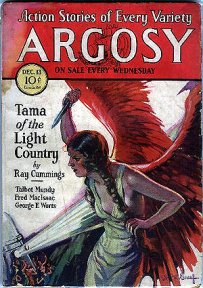
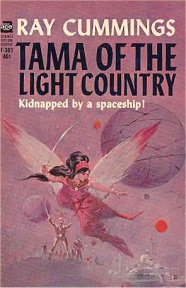
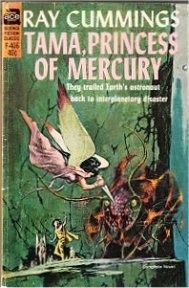
That said, I’m hardly an expert on the man. My focus is on
his Mercury stories, featuring winged women and battles of the sexes.
There are two principal novels, Tama of the Light Country, and Tama,
Princess of Mercury, from 1930 and 1931 respectively.
The second title seems a fairly deliberate riff on A Princess of Mars
suggesting that he was going for a Burroughs-style adventure.
Both of these novels are available as Ebooks for a relatively modest price.
In addition, he has a novel (published as a magazine serial but never
as a book) called The Fire People from 1922, which deals with an
invasion of Earth by monstrous denizens of Mercury's day side, and which
features the Light Country and a race of winged women. Unfortunately,
it seems inconsistent in several respects with his Tama novels.
Basically, the Tama novels borrow or plagiarize from The Fire People
but go off in different directions. In the words of R.D. Mullen,
while borrowing heavily from The Fire People, he changed important
details and simply "wrote as if it did not exist."
His A Brand New World a 1928 story about a man encountering a
winged girl from outer space also plays like a rip off of his own similar
scene in The Fire People. Meanwhile he's listed as having
a 1940 short story called Aerita of the Light Country.
The spacecraft that his protagonist flies in the Tama stories seems borrowed
from another of his own works Around the Universe.
The repeated use of Mercury as a setting or starting point, the origin
of the Light Country and winged women, and the continuing recurrence of
winged women between 1922 and 1940 across a writing career of decades suggests
that these were strongly rooted in his imagination. Not just
throwaways, but things that resonated or rested powerfully within him.
Sadly, I've only got access to the two Tama novels. It might be
an interesting project to try and reconcile The Fire People and
other works, but it won't be happening. Instead, we'll take
a good look at the Mercury of Ray Cummings.
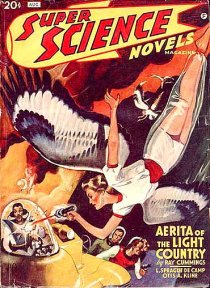
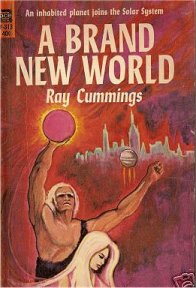
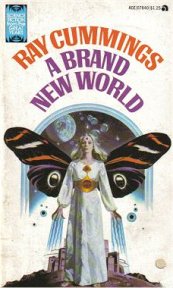
The Modern History of
the Real Mercury
So what is Cummings Mercury? As always, it draws on the science of the
time, but not too heavily. Even in the period 1922-1931, there
was no real suggestion that Mercury was any more habitable than the Moon,
and in fact, quite a bit to suggest that it was less habitable.
In the 16th or 17th century, there was some speculation that the moon
was inhabited. After all, it was a cosmic body like our own, there
were features on it that appeared to be seas. Astronomers with primitive
telescopes discerned mountains and rivers. Cyranno de Bergerac wrote
an early science fiction tale about a visit to the moon and the strange
inhabitants thereof. Even as late as the early 19th century, in the
1830s, people like Edgar Allen Poe were telling tales of Moon men, and
there was even a lively hoax in 1836 about observers discovery of bat winged
lunarians.
But by the mid-19th century, it was pretty widely accepted that the
moon was a dead and barren world. As the years progressed, interest
grew in both Mars and Venus as potential abodes for life. But Mercury
was never in any serious running.
Indeed, up until the 19th century, Mercury was known as little more
than a bright star. Being so close to the sun, there was little more
that could be discerned of it, apart from its orbit. Newtonian mathematics
allowed for calculations of its mass, and size, but that was it.
Its diameter was approximately 3025 miles, or between the Moon and Mars
in size. However, it was a remarkably dense body, the densest
in the solar system after Earth itself, which gave it a gravity of 38%
of Earth's. In comparison, Martian Gravity was about 39% of Earth's.
Mercury's greater gravity came from its much greater density, it's estimated
that the planet has a huge iron core.
Cummings was aware of this. In Tama of the Light Country,
he actually gets out his slide rule and has his protagonist tell us how
much he weighs on Mercury, and what prodigious feats of strength and leaping
he's capable of.
"...the gravity here is something less
than half that of the Earth, they (local men) move about much as you do.
But it is not so with me here. On Earth I weight about a hundred and forty
pounds. That is seventy pounds, more or less, here on Mercury. I can run
with twelve-foot strides and leap some thirty or forty feet. The Mercutian
men were afraid of me at first, but they are used to it now."
Less actually. He's got it wrong. Mercury's gravity
is about 38% Earth's, so at a hundred and forty, he'd weigh about fifty-three
pounds, give or take. Obviously, his hero isn't up on his interplanetary
gravity charts, and doesn't have an accurate set of measuring devices close
at hand. Mercurian scales probably dont read in imperial measurements.
His resulting athletic accomplishments are slightly more realistic, than
John Carter's tremendous jumps. Cummings also loads the dice a little
bit by making the Mercurians a smaller race, the men average five feet,
the women four and a half. So his hero, Guy Palisse is both
a giant and a superman among them.
In 1800, Johann Schroter made notes of surface features. Later in 1880,
Schiaparelli, the same guy who observed canals on Mars, claimed to have
mapped the surface. Although Schiaparelli's maps were reasonably
accurate under the circumstances, they didn't really catch on in any substantial
way. Mercury didn't have big flashy features like polar caps that swelled
and shrank with the year, proving the existence of water and earthlike
season, it lacked dust storms that might occlude the planet and demonstrate
the presence of a substantial atmosphere, nor did it possess defined mysterious
bright and dark areas suggestive of continents and seas, and of course,
those fabulous canals. Unlike Venus, there was no obvious cloud cover.
The inevitable conclusion was that Mercury clearly lacked water and
lacked an atmosphere. It lacked sufficient detail for any kind
of flights of imagination. Worse, its sun side was exposed
to 6.5 times more solar radiation than Earth, which meant that it must
be a blazing inferno. While the far side was as cold as the dark
side of the moon. Even back in the 19th century, Mercury was seen
as a dead and barren world.
Unlike Mars and Venus, Mercury never quite caught on in the pseudo-science
thinking of the Victorian and post-Victorian age. That thinking
had Venus as the young immature world, Mars as the old tired world, and
Earth as the happy middle. The Moon might portend the far far future,
the place where Mars was headed and Earth would eventually go. But
Mercury didn’t fit anywhere into the cosmic mythology of life and death.
So there were no great overarching narratives to it.
Instead, there was a sort of freakish curiousness about it.
Schiaparelli also suggested that Mercury's day was the same as its year,
approximately 88 terrestrial days, meaning that the planet was tidal locked.
One face permanently towards the sun, one face permanently in night. Schiaparelli's
mappings of the surface, But Schiaparelli's other suggestion, of a world
permanently tidal locked to the sun, as the moon was to Earth, took off.
The notion of a world with its two sides perpetually caught in light
and dark respectively caught on with the public and science fiction writers.
In the imagination and in fiction, Mercury's bright side was the hottest
place in the solar system, and its permanent night side was the coldest.
Well, as far as scientific romances went, this sort of sucked. Your alien
princess, or her boyfriend, was likely to be instantly flash fried or freeze
dried.
But, science fiction writers and scientists hypothesized, between them,
was a permanent twilight, a kind of border area where tolerable conditions
just might exist. Scientists pointed out, that it was still going to be
pretty inhospitable, something close to the surface of the moon. But that
was better than the inferno and icebox.
It was an attractive notion, because like Venus/Mars/Earth, it posited
two extremes and a sort of happy medium, or balance between them.
The Victorians were big fans of happy mediums, it appealed to something
in their world view. They saw themselves as endlessly situated
in a sweet spot, occupying an Island between seas and continents.
America saw itself as a favoured middle, between Europe and Asia, between
two oceans, between the pole and the tropics.
A great many science fiction writers played with this notion of Mercury
as a place of fire and ice. Isaac Asimov, notably, and Larry Niven, were
two of the most prominent, but other writers like Alan Nourse and Arthur
C. Clark went there.
Meanwhile, other writers, such as Ray Cummings and later Leigh Brackett,
fantasized a habitable realm in Mercury's twilight, a place where there
might be atmosphere and water sufficient for a civilization. After all,
Mercury's gravity was almost the same as Mars, and people were willing
to accept Martian adventures. So why not? Truthfully, writers
like Brackett and Cummings probably wouldn't have even bothered, except
that Mars and Venus were already pretty crowded with earthborne adventurers
and alien princesses. Sometimes on Barsoom you couldn't throw a heavy
rock without wrecking the rescue of some princess or other.
But even so, they didn’t actually do much with it. There are
even fewer "Mercury Adventures" than there are "Venus Adventures."
Actually, it turns out Schiaparelli was wrong. In the 1960s, astronomers
began bouncing radar beams off Mercury and discovered that its rotation
period was 55 days. Since its revolution period was 88 days,
this meant that Mercury had three "days" or rotations, every two "years"
or revolutions.
Ah well. It wouldn't have worked anyway. If Mercury had been truly tidal
locked, the fierce solar rays would have heated the atmosphere, causing
it to circulate rapidly to the dark side, which, permanently in darkness,
would have been as cold or colder than pluto. There, it would have frozen
out. In a short time, all the water on the planet would have inevitably
been stored on the dark side. And after that, you'd have gotten all the
carbon dioxide freezing out of the atmosphere and winding up on the dark
side. And after that, the nitrogen and oxygen. After that, there wouldn't
be any atmosphere to speak of. Certainly no atmosphere that could be breathed
by Cummings or Brackett's humans. And of course, while that was happening,
you'd get ferocious winds through the convection from day side to night
side, before the atmosphere was permanently locked away. And those would
make things pretty uninhabitable.
In the mid-1970s, a Pioneer spaceprobe swung by and took pictures of
48% of Mercury’s surface. The images returned to Earth showed
a sterile cratered landscape, not unlike the Moon, except that it lacked
the prominent dark "Mares" or Lunar seas. Basically, Mercury
in the science of the Ray Cummings time, was a sunblasted rock, swinging
rapidly around the sun. Not much has changed actually, it still is a sunblasted
rock swinging rapidly around the sun.
Interestingly, one thing that radar imaging showed, was that Mercury
stood tippy toe top side. That is, Mercury stands straight up. It has practically
no axial tilt, or technically, 0.01, less than one one hundredth of one
per cent axial tilt. By way of comparison, the runner up, Jupiter's
axial tilt is 3.13, or 313 times Mercury's. By comparison Earth and
Mars a staggering drunks wobbling around the solar system at 23.44 and
25.19 respectively.
What does this mean? Without axial tilt, Mercury never has
seasons. Its poles do not wobble, they are always straight and true.
But it also means that Mercury actually really does have perpetual twilight
zones. They're at the poles, broad flat areas which are permanently at
the edge of light and dark.
Indeed, there are craters and valleys at the poles which have never
had the sun shine into them, they have been eternally dark. Scientists
believe that Mercury actually has water there, at the bottom of these craters
and valleys, protected from the scorching sun. Not a huge amount of water,
they estimate, less than a tenth of that possessed by Mars, and Mars water
is but a fraction of that possessed even by the Antarctic ice cap. But
there you go. The fact that is has any at all is surpising.
Of course, there is a twilight band running around the rim of the planet.
But that band is not a permanent feature, rather, as the planet rotates,
it sweeps slowly around Mercury, every fifty five days. The result
is that any part of the planet would only be in the "habitable" twilight
for perhaps a maximum of 20 of those 55 days. The cycle would
be 10 days of "spring," 17.5 days of scorching summer. 10 days of
‘autumn’ and another 17.5 days of frigid winter. Actually, given
that Mercury has no atmosphere at all, that twilight band may be much narrower.
A day wide. Perhaps an hour. A minute. Depends
on how you slice it.
So, what else does science give us on Mercury? Circumference
9525 miles. Surface area, 28 million square miles. It
has a huge iron core, accounting for its density and remarkable gravity
(Callisto which is slightly larger has a surface gravity of only 11%, or
slightly less than 1/3). Its internal core is believed to occupy
42% of the internal volume. This is surrounded by a mantle, and then
a crust 100 miles thick.
There's no sign that there was ever plate tectonics, and little sign
of volcanism (although that is hotly debated and there are those who argue
for recent active volcanism). This is largely a dead world.
One interesting feature, however, is the presence of large ridges which
are believed to be from cooling and shrinkage. It's estimated
that Mercury's crust might have shrunk by as much as a kilometer, causing
immense folding and crunching. It's a guess, we don't know
all that much about how Mercury has developed.
There's one huge impact basin, Caloris, which sits on the equator.
810 miles in diameter, Caloris is ringed by mountains two miles high.
It's an impact on the scale of Hellas or Argyre on Mars. On
the other side of the planet from the impact is a strange jumbled disordered
territory, suggesting that the shock wave went right through, it's believed
that both the impact site and opposite side of the planet are associated
with volcanism and outgassing of tenuous atmospheric constituents.
Another peculiarity of Mercury is its orbit. At closest
approach to the sun its roughly 28.5 million miles away, at its furthest,
it is 43.5 million miles away. A difference of
15 million miles, roughly half the distance to the sun at the closest approach
and one third the distance at furthest approach. This would
mean that at closest, Mercury would be a hell of a lot hotter on its day
side than at its most distant. Since Mercury's days and years
are in 3/2 synch, this means that there'd be a consistent pattern of "super-hot"
days on specific parts of the planet on a regular basis. Mercury
also has a pronounced inclination to its orbit. It isn't on the same
plane as the rest of the planets.
These orbital peculiarities, together with Mercury's odd day and year
would lead to strange astronomical results, as noted in the Nineplanets
website:
"This fact and the high eccentricity
of Mercury's orbit would produce very strange effects for an observer on
Mercury's surface. At some longitudes the observer would see the Sun rise
and then gradually increase in apparent size as it slowly moved toward
the zenith. At that point the Sun would stop, briefly reverse course, and
stop again before resuming its path toward the horizon and decreasing in
apparent size. All the while the stars would be moving three times faster
across the sky. Observers at other points on Mercury's surface would see
different but equally bizarre motions."
Freaky, eh? One wonders how Astronomers would have coped with
a sky like that.
Cummings Mercury
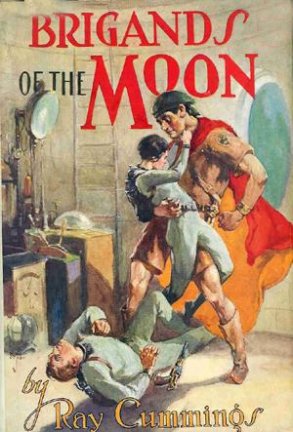 For
the most part, there aren't a lot of Mercury adventures out there.
The two Tama stories actually constitute one big novel. How does
it stack up? Not bad. I'd rank it roughly along the levels
of Farley's Radio Man series, sort of sub-Burroughs.
There are some pretty strange choices going on.
For
the most part, there aren't a lot of Mercury adventures out there.
The two Tama stories actually constitute one big novel. How does
it stack up? Not bad. I'd rank it roughly along the levels
of Farley's Radio Man series, sort of sub-Burroughs.
There are some pretty strange choices going on.
Tama of the Light Country opens up with breathless news reports
of a mysterious attack on a girls' summer camp, during which a grey-skinned
man and a winged woman are killed. In addition to being peculiar
in and of themselves, their bodies are unaccountably light, weighing about
two thirds of what they ought to.
From there, it segues into the discovery of a manuscript written by
the "sort of hero" (sort of hero in that he disappears for long portions
of both stories), Guy Palisse. Palisse it turns out had built
himself a moon rocket ten years before and disappeared. Then
with a kind of unerring sense of direction that puts one in mind of Carson
of Venus, he wound up on Mercury. His spaceship shattered, he
just sort of relaxed and fit in on Mercury's light country, going native.
Anyway, he sort of strikes a friendship with Tama, flying virgin, and
her brother Toh. It seems that Tama's a bit of a feminist or
suffragette. See, on Mercury, the women have wings and can
fly, and the men can't. So, the men, being bastards, mutilate a woman's
wings upon marriage, so she can't fly anymore. A married flying
woman and any children she has are automatically put to death.
Tama's agitating against this brutal order. However, the
results are counterproductive. The government passes a law
providing for the automatic mutilation of girls upon turning sixteen.
This incites a revolt of the winged virgins, who gather up and fly off.
Guy comes along, because, you know, they need a man to lead them.
They're feminist winged beauties... but not that feminist.
Anyway, the bad guys, led by the traitorous Roc comes after them....
And then for no good reason, the story takes a major swerve, as the Mercurian
louts decide it would be better to go to Earth and kidnap girls who were
wingless from the start... After that, the story shifts to
Earth and Space, and not too much of the story, overall, actually seems
to happen on Mercury.
And, oh yeah, there's Roc's dad, Croat, this seven foot giant dressed
in animal skins, who got exiled years before for trying to take over the
Light Country, and who has taken over the Cold Country and figured out
how to build ray guns and spaceships.... In a society where lights
are provided by animal fat lamps, and the sling is a sophisticated weapon.
Roc's dad is quite a villain, but oddly, it seems that most of his major
villainy is years before.
The second book, Tama: Princess of Mercury (she may not actually
be technically a Princess, she's more a Joan of Arc, or perhaps a Nellie
McClung), picks up the pace quite a bit. Starting on Earth
where the previous book left off, there's altogether too much time spent
on hugger muggery. Eventually, good people fall into bad hands, more
good people come to the rescue and then everyone takes off into space for
a long chase where they keep having Jerry Springer moments until finally
they get to Mercury.
Guy Palisse? He barely shows up. Instead, points of
view get fractured among two or three earthmen, and a handful of characters,
including Tama dominate the scenery. It’s pretty much impossible
to pick out a clear hero or narrative thread. It's just people having
things happen to them.
That said, when it gets to Mercury it really heats up. There's
some fairly brutal and chilling scenes of the Water City being attacked
and laid waste by an invasion from the Cold Country. This gives
way to a full scale war. Luckily, everyone lives happily ever after.
Look, both novels are available as ebooks, the price is pretty reasonable.
If you're interested, give it a chance, read it for yourself.
So, what's Cummings Mercury like? Some good, some bad.
Cummings Mercury has a breathable atmosphere, obviously. As
the Earthmen approach it from space, they see it covered by a thick greenish
cloud cover that obscures the surface. Guy Palasse, writes:
"There is generally a pall of gray cloud
masses overhead. But occasionally there are the black storms, and then
we have an inky night such as there sometimes is on Earth. Fearsome things,
these black storms. They last for two or three Earth days--sometimes longer.
I shall have much to say of one of them--it has played so large a part
in the events which have brought us now into these dire straits."
This kind of makes sense. If there was an atmosphere and any
amount of water, sheer heat on the hot side would be pumping tons of water
vapour into the upper atmosphere and creating a thick cloud cover that
would
reflect away a lot of sunlight, moderating the temperature. Otherwise,
Mercury becomes an oven, no matter where you are.
The last thing Mercury needs is a greenhouse effect, it's got to reflect
away as much sunlight as possible. Ray Cummings Mercury is probably
a much much brighter star in the sky than our Mercury.
An atmosphere which is heated on the dayside would circulate around
to the nightside, warming that. Cool air from the night side would
circulate to the dayside, leaving a bearable climate. Instead
of 900 degree differences between day and night, it might only be a hundred
or two degrees between hottest part of dayside and coldest part of nightside.
Of course, there's a problem. As clouds and water vapour
circulate to the dark side, they'd cool, condense and water would fall
out as rain or snow, and then it would fall out of circulation. Eventually,
all the water would wind up on the dark side trapped in ice and snow, which
would end the cloud covers, and that would be it. The planet
would start to heat up and turn into an oven. Of course, this
would eventually melt and release water vapour from the dark side, but
you know, it doesn’t sound like a very stable cycle... Think yo yo
with sledgehammers.
Still, Cummings is going in the right direction when he thinks heavy
cloud covers, and very volatile weather.
"Time seems different here. I have lost
count of Earth days, months and years. There are no days and nights in
the Light Country. It is in a zone of half-light-always the same brightness,
except for the weather."
The Twilight Zone should be a long narrow strip circling the planet, with
the fire country on the one side and cold country on the other.
Sadly, we don't get that impression in any clear sense. There's a
light country, and adjacent to it is the fire country and cold country,
but we get no sense of the light countries geography. Instead
of a ribbon, possibly a narrow ribbon, it's just a sort of blob of territory.
We get no clear sense of what should be peculiar dimensions.
Still, its clearly a permanent sort of place.
"I must be brief. There seems so much
to tell you! I can give you so inadequate a picture. Around the Hill City
is a barren waste of metallic coppery hills, jagged spires, canyons like
gashes filed by some Titan metalworker in mountains of metal. Bleak landscape.
For miles there is no blade of vegetation; no soil, save a metallic dust,
worn by the rain and wind. Pools of water from the rain lie glistening
in all the hollows. A fantastic landscape. It looks like nothing of Earth
or the Moon."
"This is the Light Country, the best region of
Mercury. It is not quite so forbidding. There are oases-valleys where rock
which was not metal has been worn into a soil. In them, with the abundant
rainfall and the heavy humid beat, there is always luxuriant tropical vegetation,
great spindly shafts of trees, flimsy and porous, and air vines with giant
spreading leaves and vivid, exotic flowers."
This is some of the best of it. As we've noted, Mercury is very dense
with a huge Iron core, occupying 42% of the internal volume. Indications
are that the metal content of the crust is very high. The world
is one of sunblasted baked rock, exposed to ferocious temperature extremes.
So metallic coppery hills, jagged spires, canyons like gashes, forbidding
rock, fierce ridges and immense boulders and rubble is actually very close
to what Mercury is really like.
Setting aside all that stuff about soil, rain, and vegetation.
But given the luxuriousness of Earth, it's strangely affecting and appealing
to see a world where life and plants are only an occasional thing, and
it's mostly all naked rock. It's reminiscent perhaps of some
of the weirder landscapes, particularly in the Canadian Shield or around
Drumheller, where the landscape is twisted, surging rock. It's likely
that Cummings actually wandered through some territory like this...
One thing is for sure, as used as we are to a world covered in vegetation,
it's downright unnerving.
We don't see too much of Mercury's civilization, or flora or fauna.
Certainly nothing of the vivid detail that Burroughs used to make his world
come alive.
The Light Country has six principle cities, of whom only two, Hill City
and Water City are named. It appears that the Cities are all under
some sort of central government, but the nature and operation of that government
is not all that clear. The cities of the Light Country are
pretty low tech. Light is supplied by candles or lamps burning
animal fat. Weapons generally consist of knives and slings
that launch feathered arrows. The most sophisticated weapon
is a small catapult. Basically, what we’re looking at is a
bronze or iron age society.
But at the same time, there is electricity and some electrical weapons
and tools. It seems that Mercury once sported a much more advanced
civilization, one that, with declining population, they could not sustain.
So they still have records, and perhaps remnants of death rays, handheld
lasers and even interplanetary spaceships. The Light Country
civilization preserves much of this knowledge, but doesn't seem to do much
with it.
Ironically, Hill City is not on a hill, but located in a large crater.
In such a valley the capitol, the Hill City, was built. It occupies
the bottom and the inner sides of a huge bowl-like depression in the great
metal plateau surrounding it. The level floor is perhaps five miles across.
"The level streets, tree-lined, are really
roads rather than streets. There is no congestion of houses. Fertile fields
lie around the homes, each tilled by its controller. The low houses are
built of the prevalent copper. There are gardens, trees, and always a profusion
of brilliant flowers."
"The outskirts of the City lie upon the surrounding
inner slopes of the bowl. Boulevards, like concentric rings, circle the
fifteen-mile area. And there are other streets running like spokes of a
wheel from the valley floor up to the thousand-foot height of the upper
circular rim. An artificial reservoir-lake is beside the palace, in the
center of the valley floor."
Large, but not colossal. This is a run of the mill big ass crater,
rather than a structure like the Caloris basin. It's nice that
he never actually says it's a crater, but that's obviously what it is.
Interestingly, the only other city we see, Water City, is also located
in a huge crater. That one is much wetter, with houses on stilts,
water strees, marshes and terraced agriculture. Water City
is actually described more vividly and beautifully than Hill City.
We can pretty much assume that the other cities are also occupying big
crater basins which have become fertile through trapping dust and water.
As for the people:
"Such is the Hill City. Its people, inhabitants
of this Light Country zone, are generally smaller than Earth people. The
men average perhaps five feet. They are heavy-set, squat fellows, with
wide shoulders and thick chests, but of lesser strength than an Earthman,"
Their skins are ruddy or white, their hair is jet black. No blondes
in this part of outer space. Their facial features, when described,
resemble American Indians. Their bodies, we find out early
on, are adapted to be light. Even on Earth, they weigh only about
two thirds of what they should.
Women are smaller, approximately 4'6" on average, with slender frames.
Oh, and they've got horking huge wings, with ten foot spans. They've
got feathers and everything. The wings come in different colours.
Most Mercurians are kind of runty. Although heavily built their
strength is commensurate with their planet, so that humans are powerhouses.
This kind of makes me wonder if they know what they’d be getting into with
Earth girls, who would on the whole be larger and stronger than them.
Not all Mercurians are short though, there are two freakishly huge giants
among them... The villain Croat, from the Light Country is almost
seven feet tall, while the evil Dorrek of Cold Country is about six and
a half feet.
The Cold Country, adjacent to the Light Country, is occupied by humans
as well. These people are even heavier set, flabby looking
in appearance, with gray skin. The women are gray skinned and gray
winged. Possibly the flabby appearance comes from fat storage
through harsh times.
There's a passing reference to the Cold Country having a government,
but they dress in animal skins and act like cavemen. Seriously,
these Fred Flintstone types. There’s not a lot of indication
of technology.
Oddly, under the leadership of the Light Country renegade Croat, they
manage to build a bunch of death rays and a couple of spaceships...
But strangely, they aren’t able to pilot their own spaceships and they
can’t operate their death rays very well. That, together with
their general primitiveness, suggests perhaps that they didn’t so much
build these toys as excavate them from some long lost cache.
But hey, that's me thinking out loud.
Given that the Cold Country is either on the dark side, or the darker
side of the twilight zone, you have to wonder what they're eating.
It's not like there's going to be a lot of heavy photosynthesis going on,
or spring or anything such. But there does seem to be a lot
of animals around, because they're wearing furs. Go figure.
The cold country is an area of savage geography, when the war comes
to it, the reports are of steep mountains, cliffs, and deep valleys and
chasms. Mercury is a world of stark empty jagged rock, and
the Cold Country is starker and fiercer, it makes the Light Country look
like Disneyland.
We only have a few references to the Fire Country, mostly that its inhabited
by undescribed savages. Presumably human with winged females.
It might be that Cummings pseudo-prequel novel, The Fire People
has more information for us, but unfortunately, it's not available.
There are animals on Mercury, the Cold Country folk, as I noted, are
wearing someone's furs. But there is only one animal, or other
form of life described, and this isn’t well described. The
creature is the Brue. What is the Brue?
Well, they're consistently referred to as giant insects, about ten feet
long, basically oblong in shape. When they lift up their heads
high, they're as tall as a human. The description indicates
an armoured, or shelled, jointed body, and a "myriad" of short, hairy,
spindly legs. One reference suggests a forked tail.
But there are peculiarities. The Brue has arms longer than
a human. In an early scene, one sweeps down on Guy Palasse
holding its long arms above its head. It has a round head with
a bulging forehead, a pair of deep set eyes, a wide mouth with a tongue...
It's consistently described as having a semi-human, or humanlike face which
is capable of expression. They also scream and howl with pain like
a regular animal. This is peculiar, since insects don't actually
have faces in the same way we do, the description is more reminiscent of
a humanoid, or vertebrate than an arthropod.
It does have antenna, although the descriptions of these shift.
At one point they quiver, at another, they're jointed like miniature arms,
at another they're as sinuous as an octopus' tentacles.
The Brue appear to be at least semi-intelligent. They're
domesticated and used as beasts of burden and war in the Cold Country and
the Light Country. In one early scene, one appears to listen
to Guy Palisse and then set a trap for him.
Apart from scattered and partial descriptions though, they’re simply
monsters. We don't know if they have male or female, if they're colonial
animals, do they give live births, lay eggs, have litters, what do they
eat, how smart are they, can they speak? Who knows.
Re-Imagining a Fantasy
Mercury
We've had a lot of fun with Mapping Mars and Unraveling Amtor, basically
reconciling the works of Burroughs, Kline and other writers' fictional
Mars and Venus with the topography of the real planets.
Can it be done here? Not directly. We've only got
imagery for 48% of Mercury's surface, and we don't have anything like decent
topography. On the other hand, the fictional geography of Mercury allows
for very limited mapping.
But it might be fun to try and lay the fictional Mercuries onto the
real one to see how they work. Or to try and squeeze Cummings Mercury
into the same universe as Burroughs Barsoom.
The first thing that we allow for is the Light Country.
Mercury doesn't have the sort of world spanning "twilight" zone that Cummings
and other fiction writers imagined. But it does have permanent
or near permanent twilight zones at its poles.
So in fact, the permanent light country or countries would be the two
polar areas of Mercury. This is actually nice. It sets
up a neatly Burroughsian premise of two rival but identical realms, the
north and south polar light countries, potentially at war.
Given the lack of detail, there's nothing to stop us from assigning
Cummings Light Country and its six cities to one of the polar regions.
The cloud cover is apparently heavy, scattering light around. The
only evidence might be a slow procession of shadows, and frankly, Guy doesn't
strike me as all that observant.
There is even one slight bit of evidence to suggest that instead of
being somewhere on the rim, that they're up at the pole....
Hill City. Obviously, it's not on a hill, it's in a crater
valley. So where does it get its name? Possibly
from a nearby Hill of Eternal Light.
Y'see, the pole on Mercury doesn't tilt. Which means that a deep
canyon or crater at the pole may be eternally in shadow. By
the same token, a tall enough hill may actually poke above the gentle curvature
of the pole, and in that case, its peak would always be exposed to the
sun... a peak of eternal light. So perhaps this is the
Hill that gives Hill City its name.
How big is the Light Country? Mercury's surface area is
about thirty million square miles, or 3/5ths of Earth's total land area.
That's not too bad. The stable polar areas may represent perhaps
five to ten percent of the planet's territory apiece, so perhaps one and
a half to three million square miles? At the upper end, the
Light Country would be about the size of Australia, at the lower end, Argentina.
These are pretty good sized areas. Even if we halved the lower
range, we'd still wind up with a minimum size for the Light Country of
Alaska, Texas or France. Respectable.
At first, superficially, we've got a problem with the Cold Country and
Fire Country. After all, these are stable areas adjacent to
the light country. How do we explain that?
Actually, it works better this way. Remember how I was wondering
how the hell the Cold Country managed to sustain an ecology?
What the heck were the Cold Country folk eating? Whose furs
were they getting? And what the animals providing those furs were
eating?
On Earth, we've got credible winter ecologies, with Polar Bears, Musk
Ox and all sorts of critters. But the thing is, Winter is dead time.
There's not a lot of growth. In the cold country, it's not only cold,
but presumably, they've got no photosynthesis going on. The only
way that the cold country ecology can be sustained is if they get into
the light once in a while.
So the Cold Country and the Fire Country are in the subarctic areas
of the poles. They both sustain viable ecologies, because the
slow rotation of the planet gives the Cold Country a shot at summer and
photosynthesis, and the Fire Country a shot at water in winter.
But still, doesn't that defeat the whole point. If the sub-polar
areas are rotating, then doesn't the Cold Country become Fire Country and
vice versa?
Take another look at the geography of the Cold Country. Cummings
describes steep mountains and deep chasms and canyons. This
means lots of sheltered shadow areas where ice and snow will collect and
be slow to melt. Even where the Cold Country is directly in
front of the sun, the mountain shadows, and chasms and valleys will be
cold and will lose their snow and ice only gradually. By the
time it starts to get dry, its already turning back to the night side.
We don't know the geography of the Fire Country, but we can assume that
it's most likely a flat plain or open country, without chasms or mountains
to provide shadows. It gets a lot hotter. During the
night, it probably gets cold and snow covered, but come the light, it heats
up and dries out pretty fast.
The sub-polar tribal areas probably act as a barrier, confining the
people of the light country to their narrow polar area. They
may not have much, if any, idea that an opposite pole and second light
country exists.
Indeed, this may explain the discrepancies with Cummings earlier 1922
Fire Country novel. It's just a completely different population
on Mercury, isolated from Tama's.
The implication, is that Cummings novel touches on only a relatively
small section of Mercury. There's an entire other Light Country at
the other pole, and there’s a truly strange land of a sweeping twilight
zone that continually marches as the planet rotates and revolves...
An Undiscovered Country
- Rotisserie Lands
Now, what about the place in between, the habitable twilight zone that
is away from the polar regions? Unfortunately, in contrast
to earlier expectations, this is not a stable place. Since
the planet is rotating at a 3/2 ratio, what this means is that the whole
place is on a slow rotisserie. The twilight zone is continuously
moving, forever advancing into flame and retreating into ice.
Which would make it a hard place to live. Definitely.
But perhaps not completely unbearable. What we might find are plants
and animals adapted to surviving in this harsh environment.
Assuming that the thick atmosphere scatters light and warmth, the Twilight
zone is probably a band on either side of the planet. We can't
say how thick it is. In an airless vacuum, it may be a knife
edge kind of thing, the "twilight zone" period might be an instant, a minute,
an hour. With the protection of an atmosphere, it might be as much
as five or ten days on either side, leaving eighteen or twenty two days
of blazing sun, and eighteen or twenty two days of stifling darkness, in
a fifty five day rotation.
(Actually, the time scale is a little bit more favourable than that.
Think about it. Earth has a relatively short day, 24 hours,
and a very long year, 365 days. So, in the course of a day,
the planet doesn't move very far along its orbit. So we have
no trouble calculating both day and year and keeping them separate.
But remember that Mercury is rotating very slowly and revolving very fast.
In the course of a typical Mercurian "day" of 55 days, the planet has traveled
two thirds of the way around the sun, which means that the sun is actually
in a different place relative to the planet. So that sun seems
to be going down a lot more slowly than you would think. Indeed,
it might take a lot longer than 55 or even 88 days for the sun to vanish
completely below the horizon, or for the ‘twilight’ zone to sweep completely
around the planet. Mercury probably has a "day/night" cycle
which is quite different from Earth's simple process, and is based in the
interaction between the Mercurian day and year. For anyone who is
interested in doing the mathematics of Mercury's "day/night" cycle, welcome
to it. I freely admit that it's beyond my abilities or inclination.)
The key however, to a longer day/night cycle than simply the rotation
period, is that the twilight period would be much longer as well.
Of course, the "hot day" and "cold night" would be equally longer, but
them's the breaks.
Interestingly, in Tama of the Light Country, our sort of hero
Guy mentions that plants in the light country grow incredibly fast.
You can plant a seed and have a harvest crop in a dozen day spans or so.
Now, this doesn't make a lot of sense in an area of permanent light.
But what it does suggest is that the plant life of Mercury is adapted to
very short growing seasons. Growing seasons of only a dozen days
or so.... The sort of growing season you'd expect on a constantly
moving twilight zone, where any particular spot will only be in twilight
for a dozen days or so.
We would probably see two kinds of plants. Those who sprout
and die very quickly, in the two"‘twilight" periods on either side of the
planet, and whose seeds are adapted to surviving the long fire of day and
the ice of protracted night. Or we'd see plants which put down deep
root systems to survive the harsh days and nights, and marshall their energies
for intense periods of growth and metabolic activity in the twilight zones.
So, what are animals to do with this? Well, they've got
three options. One is to dig way deep and hibernate for both
the hot day and cold night, coming out during the two twilight phases for
a desperate flurry of feeding and mating, to build up fat for the hot/cold
spells.
Another approach is to go completely underground, living like rats or
moles, digging tunnels, and feeding off the root systems of plants who
manage to endure the hot/cold cycle.
The third approach is to just stay in the twilight zone, moving with
it, so as to permanently remain in an area that is hospitable.
It would be a permanent life long migration, always a step away from a
blazing inferno or ferocious icefields.
Could it be done? Possibly. The circumference
of Mercury at its equator is 9525 miles. So assuming a 55 day
rotation, you'd need to travel about 173 miles a day to stay in the same
place. That's a hell of a clip. But there
area couple of things to think about.
Of course, the revolution period probably slows down the "day/night"
cycle. So in fact, you might only need to travel 80 or 120
miles a day to stay in the twilight zone. And that's only at
the equator. The further up or down the latitudes you go, the more
the circumference shortens and so you might go as low as 40 or 60 miles
a day.
That's pretty hard slogging. Buffalo, Caribou, Eels, Salmon, Geese
and Butterflies travel immense distances of thousands of miles during the
course of a year, so we know it can be done. If there are big
animals on Mercury, they're probably equivalent to Bison or other heavy
duty travellers.
But conceive of it in human terms. An average human walks about
two miles an hour. Lets say power walking at five miles an
hour. Let's say our average human is spending twelve hours
a day migrating in the twilight zone, sleeping eight, and reserving the
other four for every other human activity, from eating to making love to
manufacturing tools and implements.
Well at two miles an hour, our average human will burn through 24 miles
a day, which means that before too long, he's an ice cube or a fricasee.
Alternately at five miles an hour, you're up to 60 miles a day.
Which is pretty good, but unless you’re in upper latitudes, you're still
fried or frozen.
So, how to get around this? Well, the bottom line is that
critters are going to have to be travelling pretty steadily somewhere between
eight and fifteen miles an hour at the equator, just to be able to keep
up. Since full gallop, or stampede speed for most Earth herbivores
is about 30 to 35 miles an hour, we can tell that this involves some pretty
steady power movement.
The only way humans would be able to keep up is if they were riding
domesticated or semi-domesticated animals.
Or actually, there's another way for humans or other animals to do it:
Fly.
The Origins of Winged
Women
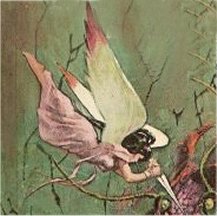 Think about it.
The temperature extremes between day and night are going to produce some
pretty ferocious atmospheric movements. On the day side,
the atmosphere is heated up and expands dramatically, spilling over into
the night side where it cools rapidly, emptying its loads of moisture,
and eventually seeping back over the twilight zone into the day side where
it heats up again. The upper levels of the atmosphere would
be pretty hot gases moving rapidly towards the night. The lower levels
would be cooled air moving towards the day. You'd get steady
and consistent winds, and absolutely ferocious thermals.
Think about it.
The temperature extremes between day and night are going to produce some
pretty ferocious atmospheric movements. On the day side,
the atmosphere is heated up and expands dramatically, spilling over into
the night side where it cools rapidly, emptying its loads of moisture,
and eventually seeping back over the twilight zone into the day side where
it heats up again. The upper levels of the atmosphere would
be pretty hot gases moving rapidly towards the night. The lower levels
would be cooled air moving towards the day. You'd get steady
and consistent winds, and absolutely ferocious thermals.
Well, we know from Albatross and Vultures that you can make a good living
as a bird by riding the thermals. Indeed, you can get some
pretty damned big birds up in the air for long periods of time riding thermals.
It's a great way to see the world.
So perhaps this partially explains the winged humans of Mercury.
Certainly the gravity and the thermals work. As Cummings explains,
the average Mercurian girl is about 4'6" and lightly built. In the
lighter gravity of Mercury. Normally, say at 4'6" a girl would
come in at about 100 lbs say... But Mercurians are adapted to be even lighter.
A Mercurian girl on Earth weighs about 65 lbs. Which means that in
Mercury’s gravity, she weighs only about twenty five or thirty pounds,
and has a ten foot or better wingspan.
Well, the forty pounds is the hard upper limit of what a bird could
get on Earth and still manage to fly, and a ten foot wingspan is about
right, or perhaps minimum for a weight like that (I would assume that the
wings of the Mercurian women have far more surface area or lifting surface
to them, being broader, than the wings of the big terrestrial birds).
And there's those amazing thermals to consider. Once a Mercurian
woman gets up into the air, she may not have to expend a lot of energy
in order to stay up there.
Perhaps this is the real reason Mercurian women are winged?
So that they can fly, and stay perpetually in the twilight zone, continually
migrating against the slow rotation of the planet. We can imagine
an entire nomadic society of women.
Of course, that suggests a "materials poor" society. Nomads
have to travel light, obviously, they can't carry too much.
Weight is particularly a premium when you're flying. On the
other hand, since Mercurian winged women will be circling the planet and
coming back to the same places at least three or four times in an earth
year, perhaps there is an opportunity to cache materials - to create temples,
silos, fortifications, houses, storage depots, etc.
Tough luck for the men though, since they have no wings.
What's their strategy. And how does it work in a society where one
sex is continually circumnavigating the planet and the other is....
Screwed?
Well, can we actually say that men are flightless in the moving Twilight
Zone? Perhaps they are winged after all.
Okay, there's no evidence of this in the Tama stories. But it
does make a certain amount of sense. After all, the stable polar
regions are the only places on the planet where flightless men would have
a competitive advantage. With a stable environment without
the need to continually migrate, flight would not be as desperately necessary.
Men could grow heavier and stronger, could accumulate more resources.
Indeed, what we see on our world is that birds who wind up on safe Islands
without predators, where conditions allow them to grow big and strong,
often become flightless. Flying birds persist, of course, but, the
big flightless birds regularly emerge.
So perhaps in the Light Country, what we're merely seeing is a local
phenomenon, flightless males in an environment that allows them to survive
and dominate. There's evidence of a ferocious eugenic drive
at work. Women are relentlessly deprived of the power of flight
upon marriage, enforcing male domination. Not only is a married
woman with intact wings automatically killed, but her children are killed
as well. One would assume a winged male child or adult would be killed
on sight. The minute the Mercurians figure they can get their hands
on wingless women, they’re jumping into a spaceship.
There is an extremely intense cultural drive there which seems mysterious.
Generally you only have to put a lot of work into something if you’re swimming
upstream... Going against the natural flow. If we had
a stable situation of flightless men and winged women would it really be
so pernicious? Or is it pernicious and violent because the
culture is enforcing something that is neither stable nor natural?
But still, if flightless men are a local phenomena, then why are the
women of the Light Country and its bordering lands still winged?
Perhaps it’s simply that the avian genes that allow for wings and features
bind to the X chromosome somehow. Two X’s guarantee wings,
and a mutation in the Y chromosome suppresses wings. Simple
genetic fluke.
Or perhaps the evolutionary or adaptive pressures on women in the Light
Country are different from that of men, and the selection of wings is sexual
dimorphism, like beardlessness and breasts on women. Wings,
however, are extremely complex ambitious structures, in comparison to breasts
or beards, so it would be surprising not to see at least some vestigial
wing structure. The lightness of male bodies suggests that
both sexes possess at least some of the adaptations to support winged flight.
Men become larger, heavier and stronger at the price of mobility, they
become more effective hunters able to bring more strength to take bigger
game. Women retain their mobility, perhaps to facilitate their
ability to mate freely, perhaps because that mobility gives them more opportunities
for gathering. So perhaps it’s a hunter/gatherer dichotomy,
with the two sexes embracing different lifestyles.
This sort of thing is not unknown in nature. Consider the
Orangutangs. Male Orangutangs are twice the size of female
Orangutangs. What this means is that the male orangutangs are
confined to the heavier branches and trunks which can bear their weight.
Meanwhile, the lighter female orangutangs can travel freely across much
lighter branches. The two sexes are literally inhabiting different
forests, with female orangutangs being far more mobile and having far more
access to food for themselves and their young.
But of course, the same logic might apply for the twilight zones.
Perhaps the Men of the twilight zones are winged. In which
case, they'd have to be as good fliers as women, no more and no less...
Because the major adaptive driver for flight is the need to stay in that
moving twilight.
Or perhaps they are not, in which case, flightless men are forced to
a radically different lifestyle. The women can endlessly fly
into to the twilight zone as it moves around the planet.
The Men have two choices. They can become equestrian nomads, trying
to find a good riding beast, and simply follow the hypothetical migrating
herds on the equivalent of horseback... A hit or miss proposition,
since we don't know if there's a suitable species.
Or they are pretty much stuck in their piece of territory.
Which means that they have two short hunting/farming/gathering seasons,
and then they're stuck sitting out weeks of hot daylight, or cold winter
in insulated cabins. Or villages.
This would make for radically different male and female cultures.
The male cultures would be territorial to an extreme degree, perhaps competitive
and aggressive, particularly considering the narrow windows they have for
gathering food and resources. A man doesn't have the time to
wait for the next round, if a rival scoops him on a bush full of berries.
There may not be time enough to get to the next bush, there may not be
another bush full of berries in walking distance, or before the fire or
the cold comes. So we may see ferocious rivalry and violent
territoriality, both within and between villages. There's probably
going to be high tensions over entitlements and property. At the
same time, they're going to be a highly time based culture. After
all, the window on gathering food and materials is narrow, what foods or
materials may be most effectively gathered at what time is a very important
question. There may be a highly specific sequence of gathering
or hunting activities to utilize the best timing of resources.
Even when trapped during the cold season or hot season, the males are probably
still busy, preparing, mending, digging, preserving or building their shelter,
tools, goods and clothing for the next twilight period.
In contrast, all the women have to do is stay in the twilight zone,
and their greater mobility means that they’re able to access more resources
more easily. They're not as concerned with territory, since
their territories are vaster. They're not as concerned with possession,
since their territories overlap. And they're not as concerned with
time or timing.
So how do flightless men and winged women relate, when their lifestyles
are so different? Women may have the role of traders, moving
small goods or key resources from one area to another, and this may be
critical for men. In addition, men may put a lot of time
and energy, not just into surviving, but into making their areas attractive
to women.... Having a nice house, a garden, a beautiful flower bed,
all for the purpose of getting laid by a winged babe.
Of course, if the populations grow too heavy, then there's not enough
free territory for women, and they start to compete with the hyperterritorial
men for vital resources. In that case, you might well see men coming
to regard the flying women as something like locusts. And the
women might regard the men's territoriality as a sort of theft, fencing
off what should be free.
And there are interesting issues in population distribution.
Men are distributed uniformly across the surface of the planet in small
isolated territories. While women are all in the twilight zones.
Assuming even populations overall, this would mean that women would far
outnumber the men in any particular twilight zone section.
Or if we assume that the population of men and women in a twilight zone
is even, then the total population of men would far outnumber women.
Each of these demographics might have different effects on culture and
the relations between the sexes.
Looking at the part of Mercury that Cummings writes about, we seem to
have both circumstances in play. In the Light Country, the
population of males and females appears to be about equal, or more equal
than holds in the Cold Country.
In the Cold Country, the males outnumber females by ten to one.
The peculiar disproportion of males to females in Cold Country is difficult
to explain? Do females have a vastly higher mortality rate?
Or is there some genetic glitch which just tends to produce more males?
The explanation likely leans to different mortality rates, or we'd expect
to see a similar genetic glitch in the Light Country.
In any event, we can’t do more than sketch out what might be some quite
interesting cultural issues.
Angels, Angans and Zarkoons,
Oh My
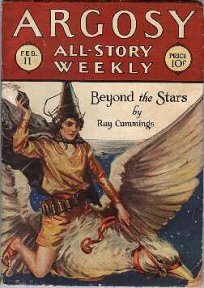 If we play the
game of "connect" the worlds, there's very little clear indication of anything
to directly connect Cummings Mercury with Burroughs Barsoom or Amtor, or
Kline's Mars or Venus. There don't seem to be any little allusions,
nor any intriguing linguistic coincidences.
If we play the
game of "connect" the worlds, there's very little clear indication of anything
to directly connect Cummings Mercury with Burroughs Barsoom or Amtor, or
Kline's Mars or Venus. There don't seem to be any little allusions,
nor any intriguing linguistic coincidences.
But it's worth noting that Cummings' winged and feathered women have
their counterparts in other other winged and feathered races, including
Kline's Bird People of Venus (or an alternate Earth), or Burroughs' Angans
of Venus, Griffith's Venusians, and Carter's Angans. There
might even be an overlap to Burroughs Weiroos whose sexual politics are
completely opposite. Although Burroughs never goes there, Leigh
Brackett writes of bird winged Martian humans or humanoids.
So it would seem that like Pseudo-Tharks, Bird-Winged Humanoids are
widely distributed through the Solar System, although only on Mercury and
parts of Venus do they form a significant population.
Unfortunately, although we can trace all the Pseudo-Tharks back to Barsoom
and argue for their origins and diversification, the Bird Winged Humanoids
are tougher. Where do they originally come from?
Mercury?
It appears that the Bird people of Mercury once upon a time had spaceships,
since they rebuild or excavate them again in the Tama stories.
So it's possible that the Mercurians sailed to other worlds and established
colonies that mutated in different ways.
Or it's possible that the spaceship technology was not Mercurian at
all. Consider that Mercury, particularly the habitable portions
stable portions of Mercury, is a very small world. Would it have
had the resources and population to eventually build a technological infrastructure
capable of spaceships?
Or perhaps more likely, the spaceships came from somewhere else.
In which case, the Mercurians are not native to their world, but transplanted
there. Somewhere around here, I've argued that Barsoom's Orovars
must have gone into space, at least to a limited extent. See
the Secret of Thuria.
And, on the basis of Otis Adelbert Kline's Martian and Moon novels, it's
confirmed that a white race of Martians did indeed go into space and have
a war with another local spacefaring race, the Ma Gongi.
So, working from there, I'd argue that the pseudo-tharks we see around
the solar system, together with little anomalies like Lin Carter's Othodes
(who seem near identical to Barsoomian calots), and an atypical six-limbed
Venusian Predator that Carson encounters (which also seems Barsoomian),
have been transported or relocated by the Barsoomian Orovars.
So, going by that, I'd suggest that the Mercurians have been transplanted
to their world from somewhere else, perhaps Venus, by the Orovars.
Then, following the collapse of Orovar civlization, the conditions were
such that on Mercury, the human races died off, leaving only the bird people.
But there’s another problem. The Mercurians are the most fully
human of the bird races. Why is this? There's no clear
answer. Perhaps this was due to tinkering or selective breeding
by the Orovars in a population small and inbred enough that it would preserve
the look. Perhaps the Mercurians represent the "base stock"
of Bird-people and the other races represent departures or mutations.
Possibly the Bird-races are fundamentally human, and have simply been artificially
or accidentally modified. I might have to wait for more evidence
before putting forth a persuasive theory.
However, there is one somewhat shaky piece of evidence I can offer for
the Orovar Origins theory: The Brue as a Pseudo-Thark.
Actually, the identification of the Brue as a member of the Thark races
is a pretty iffy one. The Brue is consistently described as an insect.
But on the other hand, Larry Niven in Rainbow Mars identifies the
Green Men as being descended from Insects or Arthropods, and several of
the other Pseudo-Tharks, particularly Farley's Formians and Kline's Sabits,
both on Venus, are also described as giant insects. So the
notion that the creatures may be seen as insectlike, particularly if the
humans have never seen anything else like them, is not necessarily a barrier.
The size of the Brue seems to be in line with the Green Men of Barsoom,
the Sabits, Formians, and others. In ground posture, roughly
ten feet long, which meant that if they were standing upright on their
two hind legs, they'd be about as tall as Green Men.
On the other hand, there are differences. The Thark
races are all six limbed. The Brue are described as having
a "myriad" of short hairy legs, and at least one pair of arms. Or
perhaps the front legs double as arms. Well, that's a minimum of four to
six "legs." Is that a myriad? Perhaps because they move
so fast it might follow. Cummings never gives us an accurate count of limbs,
so it could be four or six, or they could be veritable centipedes.
There's also a reference in one scene to a forked tail, which is hard to
explain, except perhaps as sloppiness in the heat of the moment.
Unlike the upright Tharks, but like the Sabits and Formians, the Brue seem
to prefer to go on all fours, or sixes.
Of course, Barsoom is full of multi-limbed predators. Banths,
Calots, Ulsios, Apts, some of which have eight or ten legs. So, conceivably,
the Brue could be more closely related to one of those. Except...
that the Brue has a face, a semi-human face, with deep set eyes, an expressive
mouth, and a forehead. And more than that, the Brue appears
to be intelligent or semi-intelligent.
To be truthful, I’m pretty sure that Cummings did not intend the Brue
to be Tharks or that he was inspired by Tharks in any way. The best
that we can say on that side of the coin is that he was almost certainly
had read A Princess of Mars and its sequels, and that there was
some conscious or unconscious copying of Burroughs, as in his titles.
But on the other hand, his description of the Brue is scattershot and
vague enough that if we want to, we can assign it to the category of pseudo-tharks.
It may not be an entirely comfortable fit, but it is a fit.
What this means, however, is that if we accept that the Brue are another
Thark offshoot, transplanted from Barsoom, then this means that the most
likely way they got there was by transportation through the Orovars. And
in turn, this raises the likelihood that the winged Mercurians and their
civilization were also transplanted by the Orovars as well.
The Mercurians may originally be from Venus, and their culture may derive
in part from the Martians.
Of course, this begs the question as to whether, in Barsoom's universe,
Mercury is inhabited at all. On this score, I’ll let Ras Thavas,
from chapter three of Master Mind of Mars, speak:
"From what I know of Earth and from what
I have seen of you, I am convinced that there is no mind upon your planet
that may even faintly approximate in power that which I have developed
during a thousand years of active study and research. Rasoom (Mercury)
or Cosoom (Venus) may possibly support intelligences equal to or even greater
than mine. While we have made some study of their thought waves, our instruments
are not yet sufficiently developed to more than suggest that they are of
extreme refinement, power and flexibility."
So clearly, in Burroughs Universe, Mercury is an inhabited world.
And if Burroughs has chosen not to fill that world in for us, then I think
we can find ourselves justified in accepting Cummings vision as a part
of the Barsoom universe.


